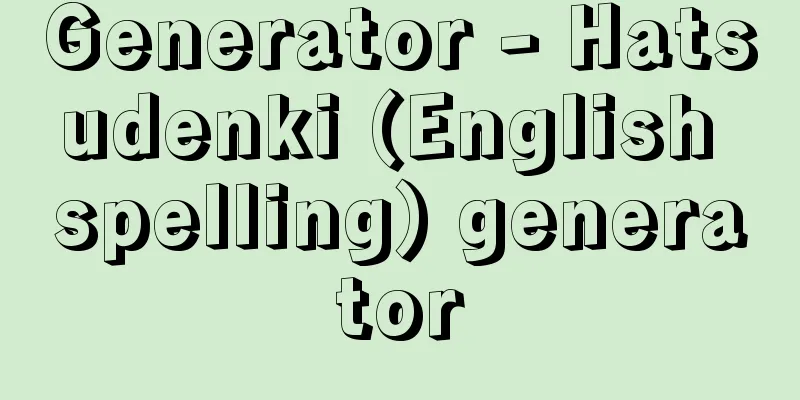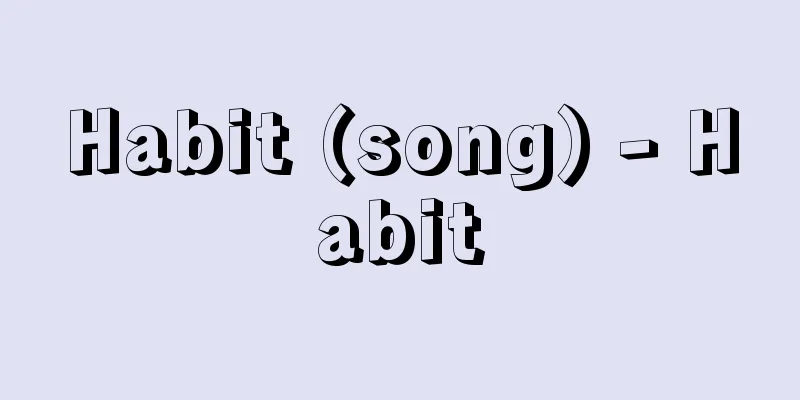Generator - Hatsudenki (English spelling) generator

|
A general term for energy conversion devices that convert kinetic energy (rotational motion) into electrical energy. Rotating electrical devices can operate as either electric motors or generators, but those designed specifically for the purpose of generating electricity are called generators. There are various types of generators, including DC generators, synchronous generators, and induction generators. [Masayuki Morimoto] Early generatorsFollowing M. Faraday's discovery of electromagnetic induction, generators were developed at the same time as electric motors. Early generators used the rotation of a permanent magnet. In 1832, Hippolyte Pixii (1808-1835) succeeded in generating "wave electricity" by passing a rotating permanent magnet close to a coil. This was the prototype of modern AC generators. Later, in 1869, Z. T. Gramm invented a DC generator using electric brushes and coils. Later, in 1881, E. W. Siemens produced a practical AC generator. At this time, there was also debate over whether electricity should be transmitted as DC or AC, and various DC generators such as the Edison dynamo were developed. [Masayuki Morimoto] principleWhen a straight conductor is placed in a magnetic field and moved perpendicular to the magnetic field, an electromotive force E = Blv (units: volts) is generated in the conductor, where B is the magnetic flux density of the magnetic field (tesla), l is the length of the conductor in the magnetic field (meters), and v is the speed of the conductor (meters per second). The direction of the electromotive force is given by Fleming's right-hand rule. The movement of the conductor with respect to the magnetic field only needs to be relative, and even if the conductor remains stationary and the magnetic field moves upward at a speed v , the magnitude and direction of the electromotive force generated in the conductor will be the same as when the conductor is moved downward at a speed v . In an actual generator, either the magnetic poles or the conductor are rotated to create relative motion. [Naoyoshi Isobe and Masayuki Morimoto] Generator typesIn principle, generators have the same structure as electric motors. Therefore, like electric motors, generators are classified according to the type of terminal voltage (whether they generate DC power or AC power) and whether the rotation speed and the frequency of the generated power are proportional (synchronous). Therefore, generators are classified as follows, combining electric motors and generators, such as DC motors and induction motors. [1] DC Machine (2) Separately excited separately excited DC machine, permanent magnet DC machine. [2] AC Machine (2) Induction machines (asynchronous machines) Squirrel-cage induction machine, wound-rotor induction machine, single-phase induction machine. (3) AC commutator (universal motor). On the other hand, in addition to being classified according to their principles, generators are also classified according to the prime mover that drives them. (1) Turbine generator: A high-speed generator driven by a gas turbine or steam turbine. (2) Water turbine generator A low-speed generator driven by a water turbine. (3) Engine generator: A synchronous generator that uses a diesel engine or other type of engine as its prime mover. (4) Wind turbine generator: A very slow generator driven by a wind turbine. (5) Other generators: Magneto generators, alternators, Edison dynamos, electric generators. [Masayuki Morimoto] "Handbook of Electrical Engineering, 7th Edition (2013)" edited and published by the Institute of Electrical Engineers of Japan [References] | | | | | | | | | | | | |Source: Shogakukan Encyclopedia Nipponica About Encyclopedia Nipponica Information | Legend |
|
運動エネルギー(回転運動)を電気エネルギーに変換するエネルギー変換機器の総称。回転電気機器は電動機動作と発電機動作が可能であるが、とくに発電を目的として設計されたものを発電機とよんでいる。直流発電機、同期発電機、誘導発電機などの形式がある。 [森本雅之] 初期の発電機発電機はM・ファラデーの電磁誘導の発見に続き、電動機と同時期につくられている。初期のものは永久磁石の回転を利用していた。1832年にピクシーHippolyte Pixii(1808―1835)が回転する永久磁石をコイルの近くを通過させて、「波打った電気」を製造することに成功した。これが現在の交流発電機の原型である。その後、1869年のZ・T・グラムは電気ブラシとコイルを使った直流発電機を発明した。その後、1881年にはE・W・ジーメンスが実用的な交流発電機を製造した。またこのころは送電を直流にすべきか、交流にすべきかの議論もあり、エジソンダイナモなどの直流発電機も種々開発された。 [森本雅之] 原理磁界中に直線導体を置き、導体を磁界と直角の方向に運動させると、導体にはE=Blv(単位はボルトV)で表される起電力を生ずる。ここにBは磁界の磁束密度(テスラ)、lは磁界中にある導体の長さ(メートル)、vは導体の速度(メートル毎秒)である。起電力の向きはフレミングの右手の法則によって示される。 磁界に対する導体の運動は相対的であればよく、導体を静止させたままとし、磁界を上方へ速度vで動かしても導体に生ずる起電力の大きさと向きは、導体を下方に速度vで運動させた場合と同じになる。実際の発電機では、磁極か導体のいずれかを回転させて相対運動をさせる。 [磯部直吉・森本雅之] 発電機の種類発電機は原理的には電動機と同一の構造である。したがって発電機も電動機と同様に、端子電圧の形態(直流電力を発電するか交流電力か)および回転速度と発電電力の周波数が比例する(同期する)かにより分類される。したがって直流機、誘導機などの電動機と発電機をあわせた呼び方で以下に示すような分類が行われる。 〔1〕直流機 (2)他励 他励直流機、永久磁石直流機。 〔2〕交流機 (2)誘導機(非同期機) かご形誘導機、巻線形誘導機、単相誘導機。 (3)交流整流子機(ユニバーサルモーター)。 一方、発電機は原理的な分類のほかに、駆動する原動機によっても分類される。 (1)タービン発電機 ガスタービン、蒸気タービンで駆動される高速の発電機。 (2)水車発電機 水車で駆動される低速の発電機。 (3)エンジン発電機 ディーゼルエンジンや各種のエンジンを原動機にもつ同期発電機。 (4)風力発電機 風車で駆動される超低速の発電機。 (5)その他の発電機 マグネト発電機、オルタネータ、エジソンダイナモ、電動発電機。 [森本雅之] 『電気学会編・刊『電気工学ハンドブック』第7版(2013)』 [参照項目] | | | | | | | | | | | | |出典 小学館 日本大百科全書(ニッポニカ)日本大百科全書(ニッポニカ)について 情報 | 凡例 |
<<: Electricity-generating organ
>>: Power generation - Hatsuden
Recommend
Mallotus japonicus - Mallotus japonicus
A deciduous tall tree of the Euphorbiaceae family...
Indirect representation
(noun) To perform a legal act in one's own nam...
Alarm Monitor - Alarm Monitor
...This type of monitor needs to be small and lig...
Articulation
In educational terms, this refers to the connectio...
Justification and Reconciliation - Ginnin to Wakai
…In Protestantism, K. Barth in particular establi...
Ishikari Bay New Port
A port in Hokkaido. Established in April 1978. The...
Hanging fish
〘Noun〙 (From the absence of the glottal stop "...
Ludwig, Carl Friedrich Wilhelm
Born: December 29, 1816, Witzenhausen Died: April ...
Lares Praestites (English spelling)
…The Lares Familiares, the guardian deities of fa...
Lares Familiares (English spelling) LaresFamiliares
…The singular form is Lar, but the plural Lares i...
Kaminominezaki
…Oshima Tsumugi is a specialty of Hahama. Kannomi...
Emancipists
These are the convicts and pardoned people who fou...
"Kagamiyama Manuscript" - A commentary by Kagamiyama Sato
… [Yuichi Takazawa] [Kaga Noisy Animals] This ref...
Okano Town
…It is located in the Higashikubiki Hills, in the...
theory of satisfaction
…Anselm linked atonement to the incarnation of Ch...



![Kawai [village] - Kawai](/upload/images/67cb45b54be6e.webp)





